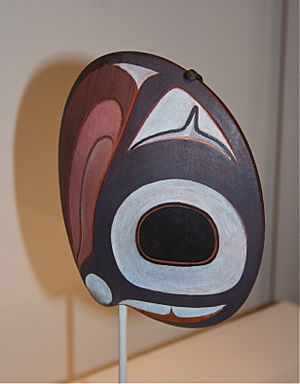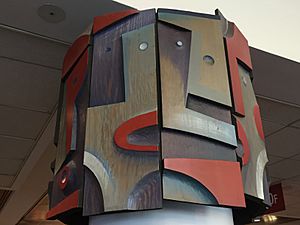James Schoppert facts for kids
Quick facts for kids
James "Jim" Schoppert
|
|
|---|---|
| Born | May 28, 1947 |
| Died | September 2, 1992 (aged 45) |
| Nationality | American |
| Known for | Woodcarving, sculpture, painting, poetry |
| Movement | Northwest Coast art, contemporary Native art |
Robert James "Jim" Schoppert (born May 28, 1947 – died September 2, 1992) was a very talented Tlingit Alaska Native artist. He was also an educator. Jim created amazing works using woodcarving, painting, and even writing poems and essays. People called him an innovator because his art went beyond what was usually expected from Northwest Coast art.
Throughout his life, Jim spoke up for Alaska Native artists and all visual artists. He taught as a guest professor at the University of Alaska Fairbanks (UAF). He also gave talks at schools in Alaska and Washington.
Contents
Jim Schoppert's Early Life
Jim Schoppert was born in Juneau, Alaska. His father was of German background, and his mother was Tlingit.
Jim Schoppert's Art Career
In 1973, Jim Schoppert went to Anchorage for a construction job. But the job was no longer available. On February 26, using his very last money, he bought a piece of soapstone. He carved an owl from it. His sister told him to sell it, and he sold it quickly! This was the start of his art career.
Jim knew that learning was important. He earned a Bachelor of Fine Arts (BFA) degree from the University of Alaska Anchorage. Then he got a Master of Fine Arts (MFA) degree from the University of Washington. Steven Brown, a curator at the Seattle Art Museum, said that Jim "apprenticed with himself." This means he learned a lot on his own.
Even while he was still in college, Jim kept making art. In 1976, he won first place in a big art show called Earth, Fire and Fiber. This award showed that he was going to be a unique artist. Jim often chose a different way to create art. His work did not always fit neatly into traditional Northwest Coast art.
He once said that there was a lot of pressure from art collectors and experts. They wanted art that looked like the classic Northwest Indian style. If his art was different, they would wonder what to do with it. This way of thinking helped Jim create his most famous pieces. These were large carved panels made from many wooden planks. He painted them with colors not usually seen in old Tlingit carvings. He also rearranged the planks to make a completely new look. This was a big change from old methods. Examples of this style are his works Teasing Eagle and Raven Opens Box of Stars.
During his art career, Jim also helped out on the state arts councils in both Alaska and Washington. He designed a special flat design for the entrance to the west end of the I-90 tunnel in Seattle. Many of his artworks can be found across Alaska and Washington. One of his last pieces was a large carving for the Port of Seattle. It was placed at the Seattle–Tacoma International Airport.
Jim Schoppert's Artwork Style
Jim Schoppert's art used many different techniques. He did woodcarving, abstract paintings, drawings, and mask making. His large, carved panel pieces were especially famous. These wood panels also caused some debate. People wondered if his art was traditional Northwest Coastal art or something new.
Jim learned that the Tlingit formline style, which was seen as the usual method, was actually a fairly new development among Northwest Indian artists. He believed that forcing artists to only use styles from the 1850s or 1950s was like telling them they couldn't be creative. He famously said, "Learn the rules, then break them."
When he talked about his panels, Jim wanted to help art grow. He felt he was following its natural path. He said, "If Art has a Master, Imagination cracks the whip." (1987) It is clear that he truly believed this when you look at his work. He went beyond the usual limits of Northwest Coastal art. He helped modern Native art change and grow.
Even though Jim Schoppert is best known for his unique panels, he also made many pieces that followed traditional methods. This is clear in his mask making. For example, his mask Forehead Mask (1977) and Mussel Shell Rattle (1992) show his use of traditional styles. He also had paintings and drawings that featured Native subjects but did not use the formline style.
Jim Schoppert's Art Shows
Jim Schoppert's art was shown in many places:
- 1984: "The New Native American Aesthetic", Marilyn Butler Gallery, Santa Fe
- 1984: C.N. Gorman Museum at University of California, Davis
- 1985: "New Ideas from Old Traditions", Yellowstone Arts Center
- 1985: North Central Washington Museum, Wenatchee, WA
- 1985: "Visage Transcended: Contemporary Native American Masks", American Indian Contemporary Arts Gallery, San Francisco
- 1985: Second Biennial Invitational, Heard Museum, Phoenix
- 1986: "What is Native American Art?'"
- 1989: "Native American Expressions of Surrealism", Sacred Circle Gallery, Seattle
- 1990: "Northern Lights", SunRunner, Ojai, CA
- 1990: "Eleven Stories", Sacred Circle Gallery, Seattle
- 1991: "Eleventh Anniversary Show", Stonington Gallery, Seattle
- 1991: "Raw Materials", Sacred Circle Gallery, Seattle
- 1991: "A Northern Perspectives", The Legacy Ltd., Seattle
- 1992: "Salmon:Ritual and Resource," Stonington Gallery, Seattle
- 1992: "Visions of Alaska", Denise Wallace Gallery, Santa Fe
- 1992: "Instrument of Change: Retrospective Exhibition", Smithsonian National Museum of the American Indian, George Gustav Heye Center New York City
Shows After His Death
Seven years after Jim Schoppert passed away, the Anchorage Museum held his final exhibition. This traveling show included 50 pieces of his art, along with some of his essays and poems. It was a way to honor a great Alaska Native artist. The museum recognized him as an artist who changed things and helped modern Native art grow. This exhibit was sponsored by the National Museum of the American Indian. It was shown at the Smithsonian Institution from October 3, 1999, to February 6, 2000, at the museum's George Gustav Heye Center.




